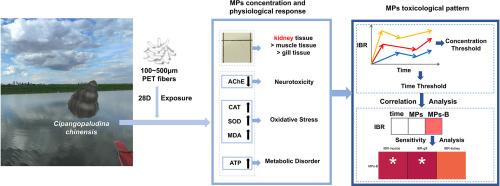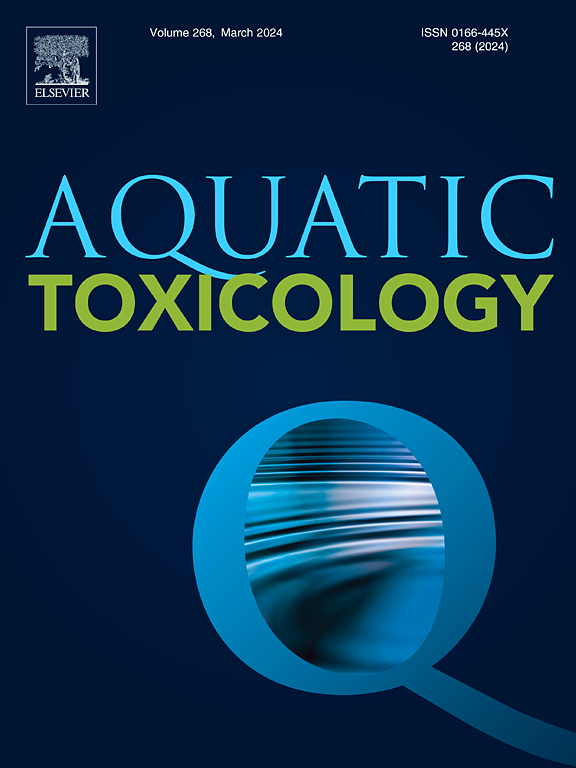Bioaccumulation and biochemical impact of polyethylene terephthalate microplastics in Cipangopaludina chinensis: Tissue-specific analysis and homeostasis disruption
IF 4.1
2区 环境科学与生态学
Q1 MARINE & FRESHWATER BIOLOGY
引用次数: 0
Abstract
Microplastics are a novel pollutant that adversely affect freshwater benthic organisms. However, few studies have investigated the mechanism underlying the bioaccumulation and the toxicity of microplastics. In this study, microplastics bioaccumulation of wild Cipangopaludina chinensis in the Songhua River were utilized, and a 28-day aquatic toxicity test was performed to determine the effects of exposure to polyethylene terephthalate (PET), the bioaccumulation of PET, and changes in multiple biomarkers in the muscle, gill, and kidney tissues. The concentration pattern of microplastics was as follows: kidney tissue > muscle tissue > gill tissue. Microplastic ingestion caused AChE inhibition led to significant increases in redox and energy metabolism indicators. Furthermore, the IBR analysis presented a "response-resistance-breakdown" process, indicating that Cipangopaludina chinensis possessed resistance with time (D14 and D21) and concentration (0.10 mg/L and 1.00 mg/L) thresholds. Tissue sensitivity to microplastics was ranked as gill > muscle > kidney, which was the opposite order of microplastic accumulation. These findings implied that less sensitive tissues stored a larger amount of pollutants, suggesting a reduction in tissue sensitivity to microplastics with higher microplastic occurrence rates. This study provides new insights into biological resistance to pollutant stress, warranting further investigation into the underlying mechanisms.

聚对苯二甲酸乙二醇酯微塑料在Cipangopaludina chinensis体内的生物累积和生化影响:组织特异性分析和稳态破坏。
微塑料是一种对淡水底栖生物产生不利影响的新型污染物。然而,很少有研究对微塑料的生物累积和毒性机制进行调查。本研究以松花江中的野生鲤鱼为研究对象,进行了为期28天的水生毒性试验,以确定暴露于聚对苯二甲酸乙二醇酯(PET)的影响、PET的生物累积以及肌肉、鳃和肾组织中多种生物标志物的变化。微塑料的浓度模式如下:肾组织 > 肌肉组织 > 鳃组织。摄入微塑料导致 AChE 受抑制,从而导致氧化还原和能量代谢指标显著增加。此外,IBR分析呈现出一个 "反应-抵抗-崩溃 "的过程,表明Cipangopaludina chinensis在时间(D14和D21)和浓度(0.10 mg/L和1.00 mg/L)阈值下具有抵抗力。组织对微塑料的敏感性排序为鳃>肌肉>肾脏,这与微塑料积累的顺序相反。这些研究结果表明,敏感性较低的组织会储存更多的污染物,这表明随着微塑料发生率的升高,组织对微塑料的敏感性也会降低。这项研究为生物抗污染物压力提供了新的见解,值得进一步研究其潜在机制。
本文章由计算机程序翻译,如有差异,请以英文原文为准。
求助全文
约1分钟内获得全文
求助全文
来源期刊

Aquatic Toxicology
环境科学-毒理学
CiteScore
7.10
自引率
4.40%
发文量
250
审稿时长
56 days
期刊介绍:
Aquatic Toxicology publishes significant contributions that increase the understanding of the impact of harmful substances (including natural and synthetic chemicals) on aquatic organisms and ecosystems.
Aquatic Toxicology considers both laboratory and field studies with a focus on marine/ freshwater environments. We strive to attract high quality original scientific papers, critical reviews and expert opinion papers in the following areas: Effects of harmful substances on molecular, cellular, sub-organismal, organismal, population, community, and ecosystem level; Toxic Mechanisms; Genetic disturbances, transgenerational effects, behavioral and adaptive responses; Impacts of harmful substances on structure, function of and services provided by aquatic ecosystems; Mixture toxicity assessment; Statistical approaches to predict exposure to and hazards of contaminants
The journal also considers manuscripts in other areas, such as the development of innovative concepts, approaches, and methodologies, which promote the wider application of toxicological datasets to the protection of aquatic environments and inform ecological risk assessments and decision making by relevant authorities.
 求助内容:
求助内容: 应助结果提醒方式:
应助结果提醒方式:


